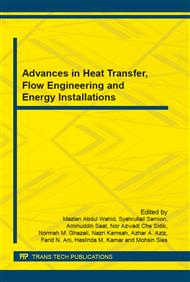[1]
S. Kakaç, A. Pramuanjaroenkij, Review of convective heat transfer enhancement with nanofluids, Int. J. Heat Mass Tran. 52 (2009) 3187-3196.
DOI: 10.1016/j.ijheatmasstransfer.2009.02.006
Google Scholar
[2]
H. Demir, et al., Numerical investigation on the single phase forced convection heat transfer characteristics of TiO<sub> 2</sub> nanofluids in a double-tube counter flow heat exchanger, Int. Commun. Heat Mass. 38 (2011) 218-228.
DOI: 10.1016/j.icheatmasstransfer.2010.12.009
Google Scholar
[3]
L. Godson, et al., Enhancement of heat transfer using nanofluids—an overview, Renewable and Sustainable Energy Reviews. 14 (2010) 629-641.
DOI: 10.1016/j.rser.2009.10.004
Google Scholar
[4]
M.C.S. Reddy, V.V. Rao, Experimental investigation of heat transfer coefficient and friction factor of ethylene glycol water based TiO2 nanofluid in double pipe heat exchanger with and without helical coil inserts, Int. Commun. Heat Mass. 50 (2014) 68-76.
DOI: 10.1016/j.icheatmasstransfer.2013.11.002
Google Scholar
[5]
J. Maxwell, A Treatise on Electricity and Magnetism, Vol. 1 Clarendon Press, Oxford, UK. 1873.
Google Scholar
[6]
J.C. Maxwell, A treatise on electricity and magnetism, Vol. 1.: Clarendon press. 1881.
Google Scholar
[7]
V. Bianco, O. Manca, S. Nardini, Numerical investigation on nanofluids turbulent convection heat transfer inside a circular tube, Int. J. Therm. Sci. 50 (2011) 341-349.
DOI: 10.1016/j.ijthermalsci.2010.03.008
Google Scholar
[8]
S. Murshed, K. Leong, C. Yang, A combined model for the effective thermal conductivity of nanofluids, Appl. Therm. Eng. 29 (2009) 2477-2483.
DOI: 10.1016/j.applthermaleng.2008.12.018
Google Scholar
[9]
X.Q. Wang, A.S. Mujumdar, Heat transfer characteristics of nanofluids: a review. Int. J. Therm. Sci. 46 (2007) 1-19.
Google Scholar
[10]
S.E.B. Maiga, et al., Heat transfer enhancement by using nanofluids in forced convection flows, Int. J. Heat Fluid Fl. 26 (2005) 530-546.
DOI: 10.1016/j.ijheatfluidflow.2005.02.004
Google Scholar
[11]
Q. Li, Y. Xuan, J. Wang, Investigation on convective heat transfer and flow features of nanofluids, J. Heat transf. 125 (2003) 151-155.
DOI: 10.1115/1.1532008
Google Scholar
[12]
C. Tsai, et al., Effect of structural character of gold nanoparticles in nanofluid on heat pipe thermal performance, Mater. Lett. 58 (2004) 1461-1465.
DOI: 10.1016/j.matlet.2003.10.009
Google Scholar
[13]
M.K. Moraveji, M. Hejazian, Modeling of turbulent forced convective heat transfer and friction factor in a tube for Fe<sub> 3</sub> o<sub> 4</sub> magnetic nanofluid with computational fluid dynamics, Int. Commun. Heat Mass Trans. (2012).
DOI: 10.1016/j.icheatmasstransfer.2012.07.003
Google Scholar
[14]
L. Syam Sundar, et al., Experimental investigation of forced convection heat transfer and friction factor in a tube with Fe<sub> 3</sub> O<sub> 4</sub> magnetic nanofluid, Exp. Therm. Fluid Sci. 37 (2012) 65-71.
DOI: 10.1016/j.expthermflusci.2011.10.004
Google Scholar
[15]
S.Z. Heris, et al., Numerical investigation of Al2O3/water nanofluid laminar convective heat transfer through triangular duct, Nanoscale research letters, 6 (2011) 1-10.
DOI: 10.1186/1556-276x-6-179
Google Scholar
[16]
J.A. Lopez, et al., Synthesis and characterization of Fe 3 O 4 magnetic nanofluid, Revista Latinoamericana de Metalurgia y Materiales. (2010) 60-66.
Google Scholar
[17]
L. Syam Sundar, M.K. Singh, A. Sousa, Investigation of thermal conductivity and viscosity of Fe<sub> 3</sub> O<sub> 4</sub> nanofluid for heat transfer applications, Int. Commun. Heat Mass Trans. 44 (2013) 7-14.
DOI: 10.1016/j.icheatmasstransfer.2013.02.014
Google Scholar
[18]
M.K. Moraveji, et al., Modeling of convective heat transfer of a nanofluid in the developing region of tube flow with computational fluid dynamics, Int. Commun. Heat Mass Trans. 38 (2011) 1291-1295.
DOI: 10.1016/j.icheatmasstransfer.2011.06.011
Google Scholar
[19]
F.P. Incropera, A.S. Lavine, D.P. DeWitt, Fundamentals of heat and mass transfer, John Wiley & Sons (2011).
Google Scholar


